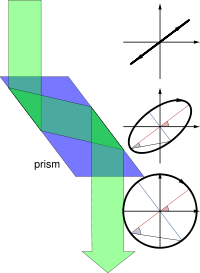Fresnel rhomb

A Fresnel rhomb is a prism designed in 1817 by Augustin-Jean Fresnel for converting linearly polarized light into circularly polarized light.[1] While the device performs the same function as a quarter wave plate, the rhomb does not depend on a material's birefringence. Rather, the relative phase shift between the s and p polarizations is a result of total internal reflection, two of which each contribute a nominal retardance of 45°. This achieves a wide spectral bandwidth which is difficult using birefringent waveplates. The precision of the 90° phase shift is compromised only due to changes in the refractive index of the material due to dispersion; this change can be very small over a wide spectral range. The material (typically glass) is itself specifically not birefringent.
The dimensions of the rhomb (usually a parallelepiped) are such that light entering one of the small faces undergoes two internal reflections, as seen in the figure, before exiting through the other small face. The angle of each internal reflection is designed to produce a 45° (π/4 radians) phase delay between the two linearly polarized components of the light. Hence a linearly polarized beam at 45° becomes elliptically polarized after the first reflection, but emerges as circularly polarized after the second reflection. For other input polarizations, the net effect of the rhomb is identical to that of a quarter wave plate. Two Fresnel rhombs can be used in tandem (usually cemented to avoid reflections at their interface) in order to achieve the function of a halfwave plate. The latter arrangement, unlike a single Fresnel rhomb used as a quarter-wave retarder, has the additional feature that the exiting beam can be collinear with the original incident beam.
The exact angle for a Fresnel rhomb to achieve the intended 90° relative phase shift depends on the material's refractive index. For example, using a glass whose refractive index n = 1.5, an internal reflection angle of incidence of either 50.2° or 53.3° meets that condition.
See also
External link and references
- ↑ A. Fresnel (1832) "Mémoire sur les modifications que la réflexion imprime à la lumière polarisée" (Memoir on the alterations that reflection imparts to polarized light), Mémoires de l'Académie des sciences de l'Institute de France, vol. 11, pages 373-434. (Note: This manuscript was submitted to the Institute on 10 November 1817 and was read to the Institute on 7 January 1823.)
- Hecht, E. (1987). Optics: Second Edition. Massachusetts: Addison-Wesley Publishing Company, Inc. ISBN 0-201-11611-1
- http://physics.kenyon.edu/EarlyApparatus/Polarized_Light/Fresnels_Rhomb/Fresnels_Rhomb.html